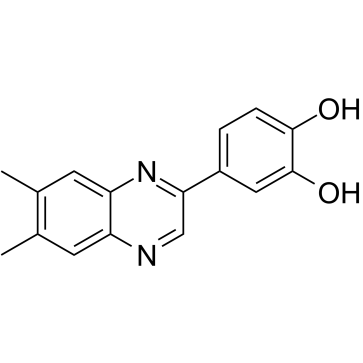| Cas No.: | 168835-90-3 |
| Synonyms: | AG1433;AG-1433;AG 1433 |
| SMILES: | OC1C(O)=CC(C2C=NC3C(=CC(=C(C=3)C)C)N=2)=CC=1 |
| Formula: | C16H14N2O2 |
| M.Wt: | 266.29 |
| Purity: | >98% |
| Sotrage: | 2 years -20°C Powder, 2 weeks 4°C in DMSO, 6 months -80°C in DMSO |
| Publication: | [1]. Serban F, et al. Silencing of epidermal growth factor, latrophilin and seven transmembrane domain-containing protein 1 (ELTD1) via siRNA-induced cell death in glioblastoma. J Immunoassay Immunochem. 2017;38(1):21-33. [2]. Strawn LM, et al. Flk-1 as a target for tumor growth inhibition. Cancer Res. 1996 Aug 1;56(15):3540-5. [3]. Kim TS, et al. The ZFHX3 (ATBF1) transcription factor induces PDGFRB, which activates ATM in the cytoplasm to protect cerebellar neurons from oxidative stress. Dis Model Mech. 2010 Nov-Dec;3(11-12):752-62. [4]. Kroll J, et al. The vascular endothelial growth factor receptor KDR activates multiple signal transduction pathways in porcine aortic endothelial cells. J Biol Chem. 1997 Dec 19;272(51):32521-7. |
| Description: | Tyrphostin AG1433 (SU1433) is a tyrosine kinases inhibitor. AG1433 is also a selective PDGFRβ and VEGFR-2 (Flk-1/KDR) inhibitor with IC50s of 5.0 μM and 9.3 μM, respectively. Tyrphostin AG1433 prevents blood vessel formation[1][2][3][4]. |
| Target: | Flk-1:9.3 μM (IC50) PDGFRβ:5 μM (IC50) |
| In Vivo: | Chorion allantoic membrane (CAM) assays are used to determine the effects of the Flk-i inhibitors on angiogenesis. Tyrphostin AG1433 (SU1433) is prepared in methylcellulose pellets and applies to the CAMs of 4-6-day-old chicken embryos. Tyrphostin AG1433 prevents the formation of new yessels under the pellets[2]. |
| In Vitro: | Tyrphostin AG1433 (0.1-100 μM; 72 hours; GB8B cells) treatment induces moderate cytotoxicity in glioblastoma cells[1]. Cell Viability Assay[1] Cell Line: GB8B cells Concentration: 0.1 μM, 1 μM, 5 μM, 10 μM, 20 μM, 30 μM, 50 μM, 60 μM, 100 μM Incubation Time: 72 hours Result: Induced significant cell death in GB8B cells in a concentration-dependent manner. |
| References: | [1]. Serban F, et al. Silencing of epidermal growth factor, latrophilin and seven transmembrane domain-containing protein 1 (ELTD1) via siRNA-induced cell death in glioblastoma. J Immunoassay Immunochem. 2017;38(1):21-33. [2]. Strawn LM, et al. Flk-1 as a target for tumor growth inhibition. Cancer Res. 1996 Aug 1;56(15):3540-5. [3]. Kim TS, et al. The ZFHX3 (ATBF1) transcription factor induces PDGFRB, which activates ATM in the cytoplasm to protect cerebellar neurons from oxidative stress. Dis Model Mech. 2010 Nov-Dec;3(11-12):752-62. [4]. Kroll J, et al. The vascular endothelial growth factor receptor KDR activates multiple signal transduction pathways in porcine aortic endothelial cells. J Biol Chem. 1997 Dec 19;272(51):32521-7. |

 DC Chemicals' products qualify for U.S. tariff exemptions. We guarantee no price increases due to customs duties and maintain stable supply, continuing to deliver reliable research solutions to our American clients.
DC Chemicals' products qualify for U.S. tariff exemptions. We guarantee no price increases due to customs duties and maintain stable supply, continuing to deliver reliable research solutions to our American clients.





















